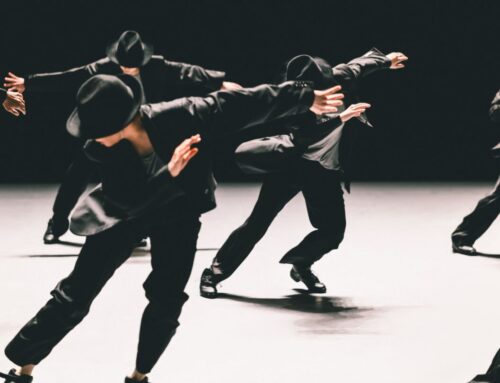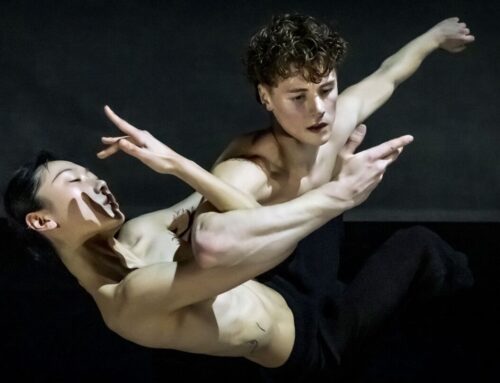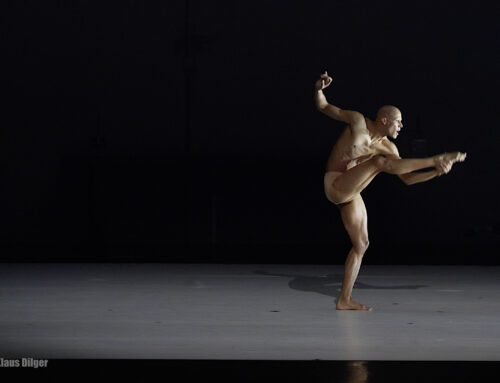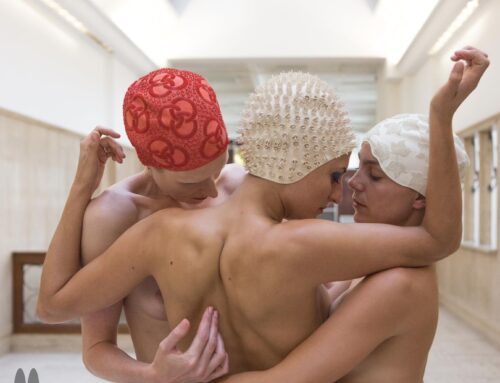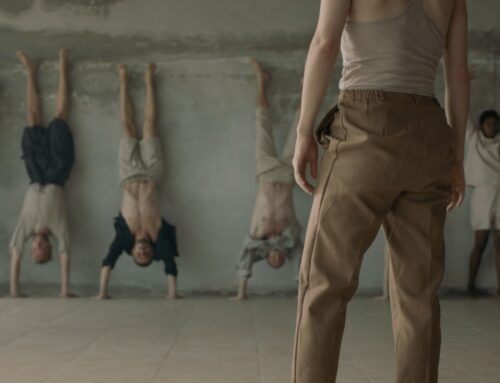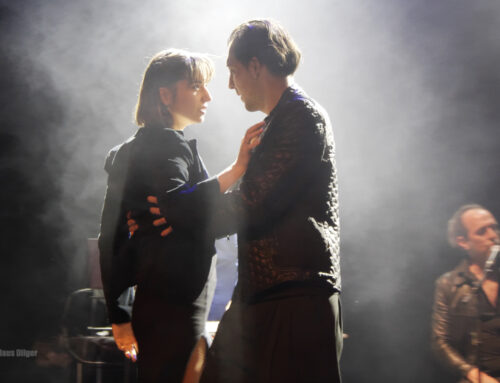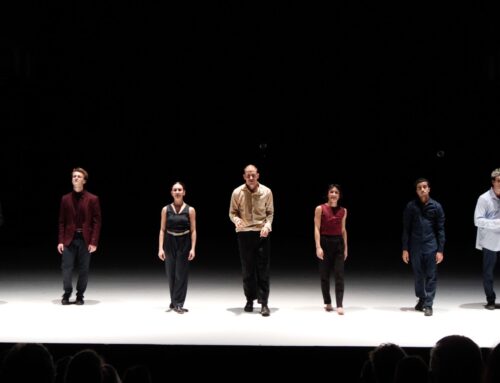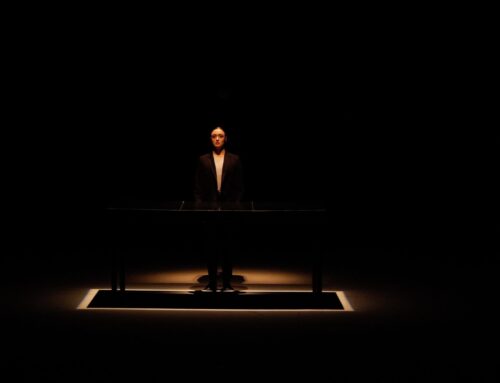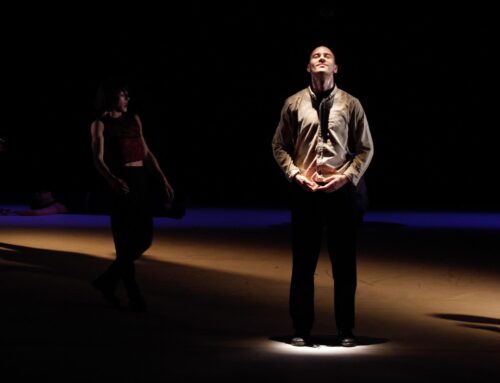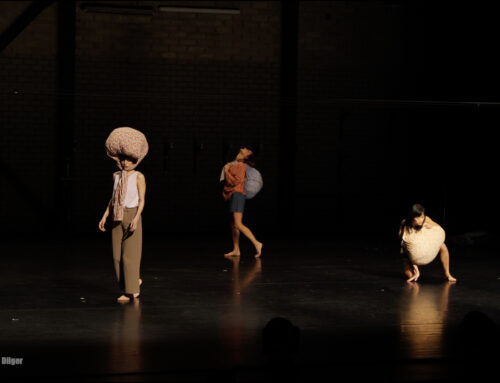schrit_tmacher-Festival: „Ce Que Le Jour Doit à la Nuit“ der französisch-algerischen Kompanie Hervé Koubi in der Aachener Fabrik Stahlbau Strang
nightreview by Nicole Strecker
translated by Silvia Werner
They may look heavy, but they are surprisingly gentle: In the streetdance scene of Algeria and Morocco, French choreographer Hervé Koubi put together an all-male cast of 16 dancers for his 2010 piece „Ce Que Le Jour Doit à la Nuit“. Since then they have shown during numerous worldwide performances how to enchantingly and gently dance those risky stunts and strenuous moves – yet they also proved that body control does not necesserily go hand in hand with physical expression. Thus from time to time severity shifts to pathos, and yet this „streetdance meditation“ remains an excitingly virtuosic evening.
It starts with a personal anecdote: Only at the age of 25, choreographer Hervé Koubi reads in German from a little note right before the performance, he discovered his roots. Not France, as he always thought, but North Africa is where his grandparents came from. Not French but Arabic is the language of his ancestors. This came as a shock to him. Hence the journey to Algeria. Hence this piece. A quest for roots. And, of course, a praise of that which unites people, instead of separating them, which is something that is being frequently emphasized by various parties these days. “Our roots are older than any national identity”, Koubi finishes his little autobiographical prologue.
The light comes up as if it was the sun. The dancers lie scattered in unidentifiable piles of bodies across the stage, single limbs emerge, they help each other up – a harmonic community. Electronic sounds remind of monastical gongs calling for morning prayer, then the first spectacular jump, a somersault. And this evening is going to feature many more of these breathtaking power moves: The cool windmills, boomerangs, jackhammers, king flares of streetdance – headspins and handstand moves in all kinds of variation. The impressively muscular and naked upper bodies of the 16 dancers add to the visual pleasure. They wear white pants with a skirt on top, which makes them look like a mixture of Capoeira-fighter and dervish. And indeed, at some point they do spin in a Sufi trance – only some of them are doing it on their heads.
A couple of years ago the Brazilian Bruno Beltrão created quite a stir when he brought some bad boys with him to Europe – some of them probably from Favelas – and presented those allegedly bad boys as gentle slow-motion virtuosi who exchanged the occasional kiss on stage and gave away the secrets of streetdance moves by delaying and deconstructing them. The French Hervé Koubi, who also holds a doctorate degree in pharmaceutics, has a similar approach to identifying the ingredients of this power dance. He cleverly divides the movement-material among this big group of dancers. He has them dancing in sync on various axes across the space, while now and then some individuals step out of line. However, the stage at the fantastic Schrittmacher location – the factory Stahlbau Strang – is clearly not big enough for those 16 muscle-boys. Now and then the only thing remaining from this stunning force is a confusing bustle of activities.
The title “What the Day Owes the Night” is a reference to a novel by author Yasmina Khadra and was also published in Germany. Khadra is a former officer of the Algerian army who emigrated to France and who has published a number of novels using this female pseudonym. “What the Day Owes…” is considered a historical roman-á-clef about the history of France and Algeria and it became a bestseller in France. Apparently choreographer Hervé Koubi is mostly interested in the colonial history as an aesthetic amalgam of orient and occident.
Ecstatically increasing Sufi music is infused with quotes by Johann Sebastian Bach, and never before has his Johannes-Passion echoed in one’s ears as stridently as it did in this moment. Before all bodies were melting in honey-golden light into one utopian community, whereas now they are becoming bulkier and more resistant. White light makes them look like enlightened apostles of monumental bible movies. Martyrs emerge, single dancers are being thrown high into the air, into the position of someone being crucified, while others are wandering the stage as if they had been struck by an epiphany. However, the excellent street dancers cannot fully convince when it comes to the quality of their expressivity. Their representation of spiritual disciples is not really believable, and even their beautifully soft counter-movements to each and every ‘tour de force’, every brilliant jump that is being delayed by milliseconds in the air as if they were flying straight to eternity, cannot help improve this impression. Fervor swells to pose and pathos, and the language of streetdance seems to lack more specific means of expression for Hervé Koubi’s dance prayer on cultural communication. Nevertheless, already the ambition to dig up the sensitive mystic in these macho bodies formed by streetdance and martial arts has its charm. And where there is no contemplation of the heart, there is still the ecstasy of a headspin.





